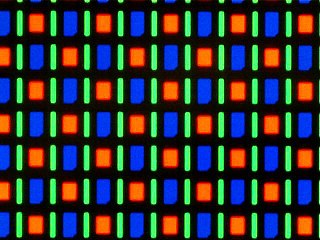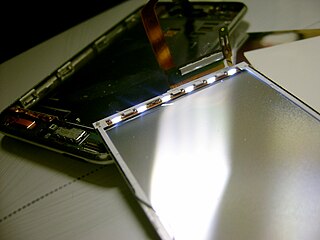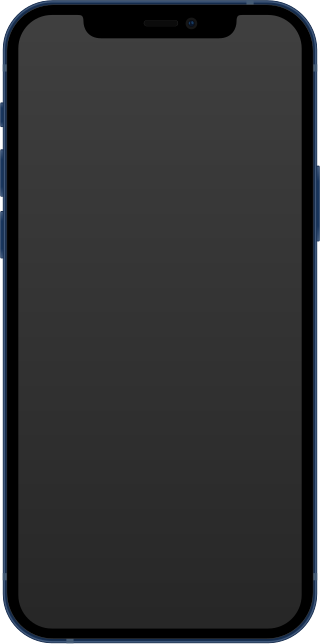
Electronic paper or intelligent paper, is a display device that reflects ambient light, mimicking the appearance of ordinary ink on paper - unlike conventional flat panel displays which need additional energy to emit their own light. This may make them more comfortable to read, and provide a wider viewing angle than most light-emitting displays. The contrast ratio in electronic displays available as of 2008 approaches newspaper, and newly developed displays are slightly better. An ideal e-paper display can be read in direct sunlight without the image appearing to fade.
Apple Inc. has sold a variety of LCD and CRT computer displays since introducing their first display in 1980. Apple paused production of their own standalone displays in 2016 and partnered with LG to design displays for Macs. In June 2019, the Pro Display XDR was introduced, however it was expensive and targeted for professionals. In March 2022, the Studio Display was launched as a consumer-targeted counterpart. These are currently the only Apple-branded displays available.
A television set or television receiver is an electronic device for the purpose of viewing and hearing television broadcasts, or as a computer monitor. It combines a tuner, display, and loudspeakers. Introduced in the late 1920s in mechanical form, television sets became a popular consumer product after World War II in electronic form, using cathode ray tube (CRT) technology. The addition of color to broadcast television after 1953 further increased the popularity of television sets in the 1960s, and an outdoor antenna became a common feature of suburban homes. The ubiquitous television set became the display device for the first recorded media for consumer use in the 1970s, such as Betamax, VHS; these were later succeeded by DVD. It has been used as a display device since the first generation of home computers and dedicated video game consoles in the 1980s. By the early 2010s, flat-panel television incorporating liquid-crystal display (LCD) technology, especially LED-backlit LCD technology, largely replaced CRT and other display technologies. Modern flat panel TVs are typically capable of high-definition display and can also play content from a USB device. Starting in the late 2010s, most flat panel TVs began to offer 4K and 8K resolutions.
An output device is any piece of computer hardware that converts information or data into a human-perceptible form or, historically, into a physical machine-readable form for use with other non-computerized equipment. It can be text, graphics, tactile, audio, or video. Examples include monitors, printers, speakers, headphones, projectors, GPS devices, optical mark readers, and braille readers.
The O2 Xda brand was a range of Windows Mobile PDA phones, marketed by O2, developed by O2 Asia and manufactured by multiple OEMs (mainly HTC, Quanta and Arima). The first model was released in June 2002. The last models came to market in 2008. The "X" represents convergence of voice and information/data within one product; the "DA" stands for "Digital Assistant", as in PDA. The name of XDA Developers is derived from it.
Art. Lebedev Studio is a design firm in Russia, founded in 1995 by Artemy Lebedev.

Elgato is a brand of consumer technology products. The brand was manufactured and designed by Elgato Systems, founded in 2010 by Markus Fest and Stuart Smith, it was headquartered in Munich, Germany, until 2018 when the brand was sold to Corsair.

The Happy Hacking Keyboard (HHKB) is a small computer keyboard produced by PFU Limited of Japan, codeveloped with Japanese computer scientist and pioneer Eiiti Wada. Its reduction of keys from the common 104-key layout down to 60 keys in the professional series is the basis for it having smaller overall proportions, yet full-sized keys. It returns the control key to its original position as on the early 84-key IBM Personal Computer/AT and XT layouts. The current models in production are the Happy Hacking Keyboard Professional Classic, Professional Hybrid, and Professional Hybrid Type-S all in either dark or light colorschemes, and either blank or printed keycaps. Professional Hybrid models are also available in Japanese layout.

MacBook is a brand of Mac notebook computers designed and marketed by Apple that use Apple's macOS operating system since 2006. The MacBook brand replaced the PowerBook and iBook brands during the Mac transition to Intel processors, announced in 2005. The current lineup consists of the MacBook Air (2008–present) and the MacBook Pro (2006–present). Two different lines simply named "MacBook" existed from 2006 to 2012 and 2015 to 2019. The MacBook brand was the "world's top-selling line of premium laptops" as of 2015.

AMOLED is a type of OLED display device technology. OLED describes a specific type of thin-film-display technology in which organic compounds form the electroluminescent material, and active matrix refers to the technology behind the addressing of pixels.
Digital newspaper technology is the technology used to create or distribute a digital newspaper.

An LED-backlit LCD is a liquid-crystal display that uses LEDs for backlighting instead of traditional cold cathode fluorescent (CCFL) backlighting. LED-backlit displays use the same TFT LCD technologies as CCFL-backlit LCDs, but offer a variety of advantages over them.

A quantum dot display is a display device that uses quantum dots (QD), semiconductor nanocrystals which can produce pure monochromatic red, green, and blue light. Photo-emissive quantum dot particles are used in LCD backlights or display color filters. Quantum dots are excited by the blue light from the display panel to emit pure basic colors, which reduces light losses and color crosstalk in color filters, improving display brightness and color gamut. Light travels through QD layer film and traditional RGB filters made from color pigments, or through QD filters with red/green QD color converters and blue passthrough. Although the QD color filter technology is primarily used in LED-backlit LCDs, it is applicable to other display technologies which use color filters, such as blue/UV active-matrix organic light-emitting diode (AMOLED) or QNED/MicroLED display panels. LED-backlit LCDs are the main application of photo-emissive quantum dots, though blue organic light-emitting diode (OLED) panels with QD color filters are now coming to market.

The Razer Switchblade was a concept design of a portable gaming device developed by Razer. It was first unveiled on January 5, 2011 at the Consumer Electronics Show (CES). The Switchblade won The Best of CES 2011 People's Voice award.

The ThinkPad X series is a line of laptop computers and convertible tablets produced by Lenovo with less power than its other counterparts. It was initially produced by IBM until 2005.

The ThinkPad W series laptops from Lenovo were described by the manufacturer as being "mobile workstations", and suit that description by being physically on the larger side of the laptop spectrum, with screens ranging from 15.6" to 17.3" in size. Most W series laptops offered high-end quad-core Intel Core processors with an integrated GPU as well as an Nvidia Quadro discrete GPU, utilizing Nvidia Optimus to switch between the two GPUs as required. Notable exceptions are the W500, which has ATI Mobility FireGL integrated workstation-class graphics, and the W550s, which is an Ultrabook-specification laptop with only a dual-core processor. The W series laptops offered independent software vendor (ISV) certifications from various vendors such as Adobe Systems and Autodesk for computer-aided design (CAD) and 3D modeling software.

The LG G series was a line of Android devices produced by LG Electronics. The "G" designation was first introduced in 2012 as a branch of the LG Optimus series for flagship devices, but LG announced in July 2013 that the "Optimus" name would be discontinued for future flagships in favor of maintaining "G" and "Vu" as distinct brands. The first purely G-branded phone, the LG G2, was unveiled in August 2013.

Sonder Design is an Australian design studio with its headquarters in Sydney at the Australian Technology Park. They designed the Sonder keyboard, a dynamic E Ink keyboard.
The Sony Xperia 10 II is a mid-range Android smartphone manufactured by Sony Mobile. Part of Sony's Xperia series, it was unveiled alongside the Xperia 1 II on February 24, 2020.

The iPhone 12 and iPhone 12 Mini are smartphones designed, developed, and marketed by Apple Inc. They are the fourteenth-generation iPhones, succeeding the iPhone 11. They were unveiled at a virtually held Apple Special Event at Apple Park in Cupertino, California, on October 13, 2020, alongside the "premium flagship" iPhone 12 Pro and iPhone 12 Pro Max and HomePod Mini. Pre-orders for the iPhone 12 started on October 16, 2020, and the phone was released in most countries on October 23, 2020, alongside the iPhone 12 Pro and fourth-generation iPad Air. Pre-orders for the iPhone 12 Mini began on November 6, 2020, and the phone was released on November 13, 2020, alongside the iPhone 12 Pro Max.














